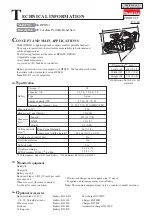
11
GB
11. Transport (fig. 2/3.1)
• Tighten the locking handle (11) to lock the rotary table.
• Press the machine head (4) downwards and secure with the
locking bolt (23).
• Fix the saw’s drag function with the locking screw for drag
guide (20) in rear position.
• Carry the machine by the transport handle (39) and the
fixed saw table (15).
• When reassembling the equipment proceed as described
under section 8.
12. Maintenance
m
Warning!
Prior to any adjustment, maintenance or service
work disconnect the mains power plug!
12.1 General maintenance measures
Wipe chips and dust off the machine from time to time using a
cloth. When cleaning the plastic do not use corrosive products.
12.2 Cleaning the moving saw blade guard safety
device (5)
Always check the saw blade guard for debris before using the
machine.
Remove old sawdust and splinters using a brush or similar
tool.
12.3 Replacing the table insert
Danger!
With a damaged table insert (10) there is a risk of small parts
getting stuck between table insert and saw blade, blocking
the saw blade.
Immediately replace damaged table inserts!
1. Remove screws at table insert. If required, turn rotary table
and incline saw head to be able to reach the screws.
2. Remove table insert.
3. Install new table insert.
4. Tighten the screws at table insert.
12.4 Changing the saw blade (fig. 2, 15-17)
Remove the power plug!
Attention!
Wear safety gloves when changing the saw blade.
Risk of injury!
• Swing the machine head (4) upwards and lock with the lock-
ing bolt (23).
• Use one hand to insert the Allen key (C) in the flange screw
(28).
• Firmly press the saw shaft lock (30) and slowly rotate the
flange screw (28) in clockwise direction. The saw shaft lock
(30) engages after no more than one rotation.
• Now, using a little more force, slacken the flange screw (29)
in the clockwise direction.
• Turn the flange screw (28) right out and remove the outer
flange (29).
• Fold the saw blade guard (5) upwards.
• Take the blade (6) off the inner flange (31) and pull out
downwards.
• Carefully clean the flange screw (28), outer flange (29) and
inner flange (31).
• Fit and fasten the new saw blade (6) in reverse order.
• Attention!
The cutting angle of the teeth, in other words
the direction of rotation of the saw blade (6) must coincide
with the direction of the arrow on the housing.
• Before continuing your work make sure that all safety de-
vices are in good working condition.
• Attention!
Every time that you change the saw blade (6),
check to see that it spins freely in the table insert (10, fig. 1)
in both perpendicular and 45° angle settings.
• Attention!
The work to change and align the saw blade
(6) must be carried out correctly.
12.5 Adjusting the laser (fig. 19)
If the laser (32) ceases to indicate the correct cutting line, you
can readjust the laser.
• Loosen the Phillips screws (E).
• Set the laser by moving sideways until the laser beam strikes
the teeth of the saw blade (6).
• Firmly secure both screws (E).
12.6 Brush inspection (fig. 20)
Check the carbon brushes after the first 50 operating hours
with a new machine, or when new brushes have been fitted.
After carrying out the first check, repeat the check every 10
operating hours.
If the carbon is worn to a length of 6 mm, or if the spring or
contact wire are burned or damaged, it is necessary to replace
both brushes. If the brushes are found to be usable following
removal, it is possible to reinstall them.
When servicing the carbon brushes, open the two latches coun-
terclockwise (as shown in figure 20). Then remove the carbon
brushes. Replace the carbon brushes in the reverse order.
12.7 Service information
Please note that the following parts of this product are sub-
ject to normal or natural wear and that the following parts are
therefore also required for use as consumables.
Wear parts*: carbon brushes, saw blade, table insert black
(art. no. 5901215010), chip collection bag
* Not necessarily included in the scope of delivery!
13. Storage
Store the device and its accessories in a dark, dry and frost-
proof place that is inaccessible to children. The optimum stor-
age temperature is between 5 and 30˚C.
Store the electrical tool in its original packaging.
Cover the electrical tool in order to protect it from dust and
moisture.
Store the operating manual with the electrical tool.
Summary of Contents for MPKZ 2000 A1
Page 5: ...17 30 16 28 29 C 12 33 34 18 31 5 6 20 E 19 32 38 E E 14 15 4 4 7 7 14 14 13 24 24a 25...
Page 93: ......
Page 94: ......
















































